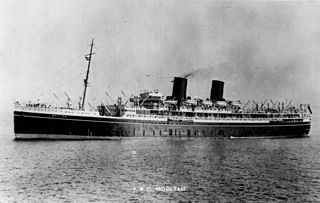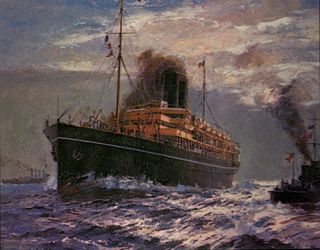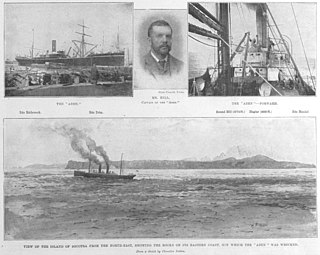
RMS Aquitania was an ocean liner of the Cunard Line in service from 1914 to 1950. She was designed by Leonard Peskett and built by John Brown & Company in Clydebank, Scotland. She was launched on 21 April 1913 and sailed on her maiden voyage from Liverpool to New York on 30 May 1914. Aquitania was the third in Cunard Line's grand trio of express liners, preceded by RMS Mauretania and RMS Lusitania, and was the last surviving four-funnelled ocean liner. Shortly after Aquitania entered service, World War I broke out, during which she was first converted into an auxiliary cruiser before being used as a troop transport and a hospital ship, notably as part of the Dardanelles Campaign.

The Pacific Mail Steamship Company was founded April 18, 1848, as a joint stock company under the laws of the State of New York by a group of New York City merchants. Incorporators included William H. Aspinwall, Edwin Bartlett, Henry Chauncey, Mr. Alsop, G.G. Howland and S.S. Howland.

P&O Cruises is a British cruise line based at Carnival House in Southampton, England, operated by Carnival UK and owned by Carnival Corporation & plc. It was originally a subsidiary of the freight transport company P&O and was founded in 1977. Along with P&O Cruises Australia, another former subsidiary of P&O, it has the oldest heritage of any cruise line in the world, dating to P&O's first passenger operations in 1837.

Hong Kong and Whampoa Dock was a Hong Kong dockyard, once among the largest in Asia.

The SS Mongolia was a steam turbine-driven twin-screw passenger-and-cargo ocean liner launched in 1922 for the Peninsular and Oriental Steam Navigation Company (P&O) for service from the United Kingdom to Australia. Later in P&O service she sailed for New Zealand, and in 1938 she was chartered to a P&O subsidiary, the New Zealand Shipping Company, as SS Rimutaka.

RMS Mooltan was an ocean liner and Royal Mail Ship of the Peninsular and Oriental Steam Navigation Company (P&O). She was ordered in 1918 and completed in 1923. She served in the Second World War first as the armed merchant cruiser HMS Mooltan (F75) and then as a troop ship. She was retired from P&O service in 1953 and scrapped in 1954.

SS Medic was a steamship built by Harland and Wolff in Belfast for the White Star Line which entered service in 1899. Medic was one of five Jubilee-class ocean liners built specifically to service the Liverpool–Cape Town–Sydney route. The ship's name pertained to the ancient Persian region of Media and was pronounced Mee-dic.

HMS Himalaya was built for the Peninsular and Oriental Steam Navigation Company as SS Himalaya, a 3,438 gross register ton iron steam screw passenger ship. She was purchased by the Royal Navy in 1854 for use as a troopship until 1894 and was then moored in the Hamoaze, Devonport to serve as a Navy coal hulk until 1920, when sold off. She was sunk during a German air attack on Portland Harbour in 1940.

SS Königin Luise was a Barbarossa-class ocean liner built in 1896 by Vulcan Shipbuilding Corp. of Stettin, Germany, for the North German Lloyd line of Bremen. She served on the company's Australian, Far East, and North Atlantic routes for nearly two decades.

RMS Medina was an ocean liner built by Caird and Company, Greenock, Scotland, in 1911, for the Peninsular and Oriental Steam Navigation Company. She was a Royal Mail Ship intended for use on the London to Australia route and was the last of the ten ships in P&O's M-Class. Between November 1911 and February 1912 Medina took King George V and Queen Mary to India for the Delhi Durbar. Medina was lost when she was torpedoed on 28 April 1917.

SS Iberia was an ocean liner completed in 1954 for the Peninsular and Oriental Steam Navigation Company (P&O). Along with her fleetmates Himalaya, Arcadia and Chusan, Iberia mainly provided passenger service between the United Kingdom and Australasia.

SS Sardinia was a cargo liner operated by the Peninsular and Oriental Steam Navigation Company between 1902 and 1925, providing both passenger and cargo services on various routes.

RMS Strathnaver, later SS Strathnaver, was an ocean liner of the Peninsular and Oriental Steam Navigation Company (P&O).
SS Nubia was a passenger steamer, built by John Laird Sons & Company in Birkenhead in 1854 for the Peninsular and Oriental Steam Navigation Company at a cost of £65,750. It was launched on 28 February 1854 and commenced formal service between Southampton and Alexandria on 4 September 1854. It was briefly used in the Crimean War later that year before continuing operations between Suez and Calcutta, passing through the port of Aden en route. On 5 October 1864, it encountered trouble during a cyclone in Calcutta and was driven ashore near King Oudh's palace and had to be refloated. In September 1867, Nubia rescued the passengers of Surat, which had run aground on a reef in the Gulf of Suez.

HMS Kashmir was a British cargo liner built during World War I for the Peninsular and Oriental Steam Navigation Company (P&O)'s Far Eastern routes. She served in that capacity until late 1916 when she was requisitioned for service as a troopship. She collided with the troopship HMS Otranto in 1918 which subsequently ran aground on the Isle of Islay with great loss of life. The ship was returned to the Peninsular and Oriental Steam Navigation Company after the war and remained in service until 1932.

The Jubilee class were a group of five passenger and cargo ocean liners built by Harland and Wolff at Belfast, for the White Star Line, specifically for the White Star Line's service from the UK to Australia on the Liverpool–Cape Town–Sydney route. The five ships in order of the dates they entered service were:

The SS Dongola, launched 14 September 1905, was a steam-powered passenger liner of the Peninsular and Oriental Steam Navigation Company (P&O), at various times used as a Royal Navy troop ship and hospital ship.

The SS Narkunda was a passenger ship commissioned in 1920 by the British shipping company, Peninsular and Oriental Steam Navigation Company, which carried passengers and mail from Great Britain to Australia and later to the Far East. From 1940 she served as a troop ship until she was sunk on November 14, 1942, on the Algerian coast during a German air raid.

SS Aden was a British combined sail and steam-driven passenger liner built in 1856 and owned by the Peninsular and Oriental Steam Navigation Company (P&O) and employed on the Far East services.


















